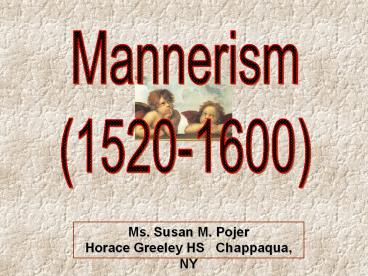Mannerism - PowerPoint PPT Presentation
1 / 38
Title:
Mannerism
Description:
Ms. Susan M. Pojer Horace Greeley HS Chappaqua, NY The Changing Role of the Artist Giorgio Vasari s Lives of the Artists, 1568. He believed that the artist was no ... – PowerPoint PPT presentation
Number of Views:27
Avg rating:3.0/5.0
Title: Mannerism
1
Mannerism (1520-1600)
Ms. Susan M. PojerHorace Greeley HS Chappaqua,
NY
2
The Changing Role of the Artist
- Giorgio Vasaris Lives of the Artists, 1568.
- He believed that theartist was no longer just
amember of a crafts guild. - The artist was an equal inthe courts of Europe
with scholars, poets, and humanists. - Therefore, the artist shouldbe recognized and
rewarded for his unique artistic technique
maneria.
3
Background
- Late Renaissance Pre-Baroque.
- Art was at an impasse after the perfection and
harmony of the Renaissance. - Antithetical to the principles of the High
Renaissance. - From the Italian de maneria.
- A work of art done in the artists characteristic
touch or recognizable manner. - First used by the German art historian, Heinrich
Wölfflin in the early 20c. - Influenced by Michelangelos later works.
4
Michelangelos Last Judgment(Sistine Chapel)
5
Michelangelos Last Judgment(Sistine Chapel
left side)
6
Michelangelos Last Judgment(Sistine Chapel
right side)
7
Features of Mannerism
8
1. Replace Harmony With Dissonance
Discord
- Susanna the Elders
- Alessandro Allori
- Twisted bodies or weight shift contrapposto
9
2. Replace Reason with Emotion
- Pietà by Rosso Fiorentino
- 1530-1540
10
- Pietà by El Greco
- 1587-1597
11
3. Replace Reality with Imagination
- The Mystic Marriage of St. Catherine
- Parmigianino
- 1525-1527
12
- Charity
- Andrea del Sarto
- 1518
- An allegory of the French royal family.
13
4. Create Instability Instead of Equilibrium
- The Rape of Helene
- Francesco Primaticcio
- 1530-1539
14
5. Bodies Are Distorted
- Christ in Agony on the Cross
- El Greco
- 1600s.
- An attempt to express the religious tensions of
the times.
15
- Adoration of theName of Jesus
- El Greco
- 1578-1580.
16
- Adoration of the Name of Jesus(details)
- Philip II of Spain
- El Greco
- 1578-1580
17
- The Baptism of Christ
- El Greco
- 1608-1628.
18
- Portrait of a Cardinal
- El Greco
- 1600
19
- St. Jerome by El Greco
- 1587-1597
20
6. Colors are Lurid
- The Tempest
- Giorgione
- 1510
21
- The Calling of St. Matthew
- Caravaggio
22
- The View from Toledo
- El Greco
- 1597
23
7. Pictoral Space is Crowded
- Madonna with the Long Neck
- Parmagianino
- 1534-1540
24
- Joseph in Egypt
- JacomoPontormo
25
- The Last Supper
- Tintoretto
- 1594
26
8. A Void in the Center
- Bacchus Ariadne
- Titian
- 1522-1523
?
27
- Pastoral Concert
- Giorgione
- 1508-1510
?
28
9. Hanging Figures
- The Annunciation
- Jacopo Tintoretto
- 1583-1587
29
- Moses Drawing Water form the Rock
- Jacopo Tintoretto
- 1577
30
Manneristic Architecture
31
Characteristics of Mannerist Architecture
- Stylishness in design could be applied to a
building as well as to a painting. - Showed extensive knowledge of Roman architectural
style. - Complex, out of step style ? taking liberties
with classical architecture. - Architecture, sculpture, and walled gardens were
seen as a complex, but not necessary unified
whole.
32
- Villa Capraor Villa Rotunda
- By AndreaPalladio
- 1566-1571
- Palladian architectural style popular in
England
33
- Entrance to the Villa Farnese at Caprarola
- By Giacomo Vignola
- 1560
34
- Giacomo da Vignola
- Wrote The Rule of the Five Orders of
Architecture - 1563
- Became a key reference work for architects.
35
The Fontainebleau School
- French Mannerism ? flourished from
1531 to the
early 17c. - Characteristics
- Extensive use of stucco in moldings picture
frames. - Frescoes.
- An elaborate often mysterious system of
allegories and mythical iconography. - Centered around the Royal Chateau of
Fontainebleau.
36
The Royal Chateau at Fontainebleau
- Gallery right by Rosso Fiorentino Francesco
Primaticcio - 1528-1537
37
Jean Goujon
Nymph Putto, 1547-1549
Nymph, 1548-1549
38
GermainPilon
- Caryatids
- 1550s































